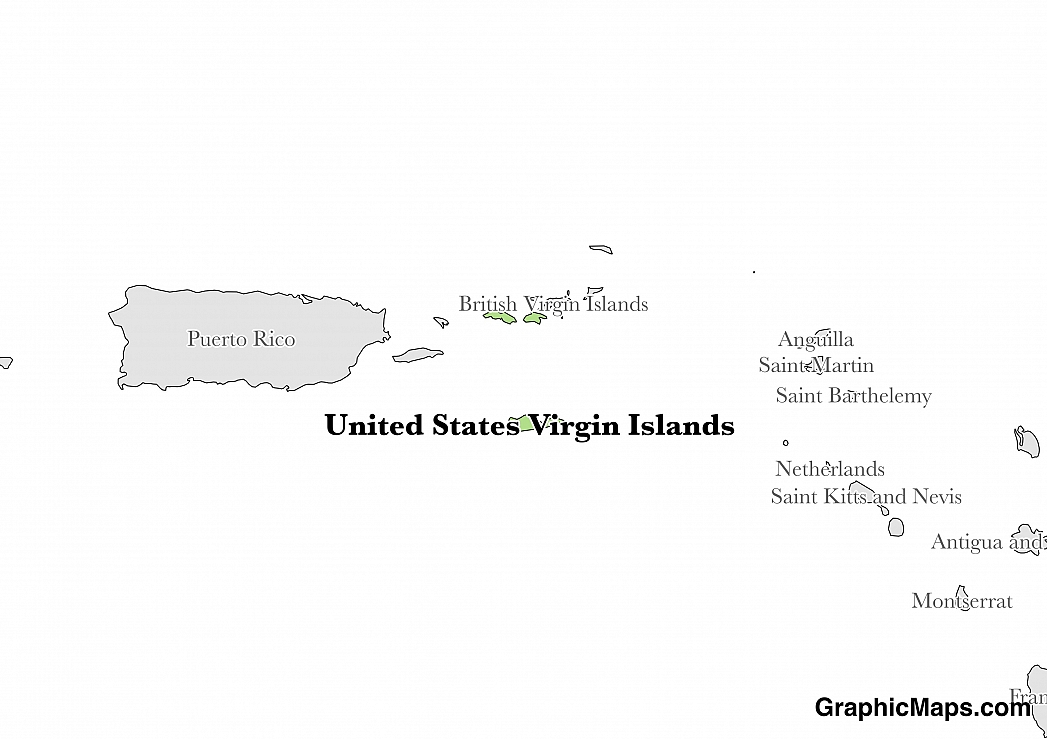Where is U.S. Virgin Islands?
Located in the Caribbean, U.S. Virgin Islands is an island nation. It has a 188.00 km coastline.
The capital of US Virgin Islands is Charlotte Amalie. It was named after Queen Charlotte Amalie, the wife to King Christian V of Denmark, in 1691. In 1921, the name was changed to St. Thomas although it was later restored to Charlotte Amelie in 1936. The capital is found in St. Thomas Island, one of the Islands in the US island territory. It is founded on three low volcanic projections namely Government Hill, Berg Hill, and Frenchman Hill. Of the 104,906 people living in the Islands, 97% are located in the urban areas. Charlotte Amalie is the largest city of the US Virgin Islands, inhabited by approximately 19,000 people. Charlotte Amalie experiences a tropical climate that is characterized by slight seasonal changes all through the year. Compared to the winter, high rainfall is experienced in the summers which last from May to October. The least amount of precipitation is experienced in February while the highest amount is received in September. The mean annual temperature is at around 26.6 degrees Celsius with July being the hottest month of the year having temperatures that hover around 28.0 degrees Celsius. January has the lowest average temperature of about 24.9 degrees Celsius. The difference between highest temperatures in the summer and winter is 3 degrees Celsius.
Read more on U.S. Virgin Islands's CapitalU.S. Virgin Islands is a North American country covering 1,910.00 km2 of which 81.88% is water and 346.00 km2 is land. and about the same size as Rhode Island. Its geographic coordinates are 18 20 N, 64 50 W and Charlotte Amalie is the capital city.
It was given its name by Christopher Columbus.
Its ISO code is VI.
Geography
U.S. Virgin Islands has a mean elevation of 0 m above sea level.
The climate is tropical with a hot and rainy season from November to April and a cool, dry season from May to October. Its terrain is mostly hilly and rugged with mountains.
Population
U.S. Virgin Islands has a population of 102,951 making it the 193rd largest in the world. The population mostly lives in and around Charlotte Amalie and Christiansted.
English, Spanish, and French are all widely spoken. The most common ethnic groups reported are black, followed by white and asian. The majority of the population identifies as Protestant Christian or Roman Catholic.
The official language in the US Virgin Islands is English, which is a Germanic language of the Indo-European language group. English was made the official language in 1917 after the islands became a United States island territory. It is the language used in government, schools, business, and in other formal settings. Before 1917, the Islands were known as Danish West Indies, and the official language was Danish even though it was never established as the official language. However, Danish is not among the languages spoken in the Islands. Out of the entire US Virgin Islands population, about 74.7% speak English, 6.6% speak French and French Creole, 16.8% use Spanish, and 25.3% speak other languages. The English language spoken in US Virgin Islands is accented and spoken hastily such that it may sound unrecognizable to Standard English speakers. Creole English also exists and has different pronunciations, unique vocabulary, and does not follow many grammatical rules. The only indigenous language in the Islands is Virgin Islands Creole and has different dialects based on where it is spoken. Negerhollands was also spoken during the Danish rule but has since become extinct. Other languages spoken in the islands are Spanish, French, and French Creole.
Read more on U.S. Virgin Islands's LanguagesThe dialing code for the country is -339.
Government
It is a territory of the United States. The Virgin Islands do not have a specific document named as their constitution.
The islands are a self-governing territory of the United States with interior department exercise Federal authority over the islands exercised by the Department of Interior. The organization of the government is defined by the Revised Organic Act of the Virgin Islands of 1954. A fifteen-member Senate makes up the Legislature of the US Virgin Islands who are elected by a simple majority to two-year terms. The senators meet in the Legislature Building in Charlotte Amalie which was completed in 1874. The Government House in Road Town is the official residence of the Governor. A non-voting delegate represents the islands to the House of the Representative.
Read more on U.S. Virgin Islands's GovernmentEconomy
Factoring in Purchasing Power Parity, U.S. Virgin Islands's GDP is $3,792,000,000.00 (USD) with $36,100.00 (USD) per capita. This makes it the 177th largest economy and its citizens the 50th richest in the world. The currency of U.S. Virgin Islands is the Dollar (USD).
Its major imports include foodstuffs, consumer goods, and building materials.
Flag
The British Virgin Islands national flag features the British Blue Ensign defaced with the nation’s coat of arms which in turn features St. Ursula who appears to be holding a flaming gold lamp in one hand and is surrounded by eleven more identical lamps. The territories flag was adopted on November 15, 1960.
Read more on U.S. Virgin Islands's FlagThis page was last modified on February 6th, 2018
More on Graphicmaps

Published on 2019-11-06
What is a Trade Embargo?

Published on 2019-11-04
Which Two Countries Used to Have the Same Flag?

Published on 2019-09-16
What Is the Only Two-Sided State Flag?

Published on 2019-09-16
Which Country Flag Looks Like the Texas Flag?

Published on 2019-08-29
Flags That Resemble the US Flag

Published on 2019-08-20
